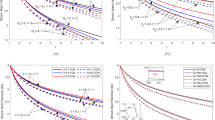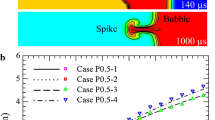Abstract
In this paper, a study concerning strong plane and cylindrically symmetric shock waves in a dusty gas atmosphere under isothermal condition has been performed, by taking into account the power series expansion method. The flow medium is assumed to be a mixture of perfect gas and small solid particles. The governing equation and associated boundary conditions are non-dimentionlized using a similarity transformation, and are hence expanded as a power series in \({\mathrm{M}}^{-2}\), where \(\mathrm{M}\) is the upstream mach number. Runga-Kutta method of order four has been used to obtain a numerical solution. The effect of (i) geometry factor and (ii) dust loading parameters on the flow variables behind the shock front has been studied in detail and their behaviour in flow field is illustrated via figures. It has been observed that the in the flow field region the quantity \({\mathrm{J}}_{0}\) increases with increase in \(\mathrm{G}\) (the ratio of density of solid particles to the initial density of perfect gas) while it decreases with increment in \({\upkappa }_{\mathrm{p}}\) (mass concentration of solid particles) and \(\mathrm{j}\) (geometry factor). Hence, \({\upkappa }_{\mathrm{p}}\) has a decaying effect on shock wave, whereas the shock grows with increment in \(\mathrm{G}\) and \(\mathrm{j}\).











Similar content being viewed by others
Abbreviations
- a a :
-
Speed of sound ahead of shock wave
- \(a_{{isoth.}}^{2}\) :
-
Isothermal speed of sound
- c sp :
-
Specific heat of solid particles
- c v :
-
Specific heat of the gas at constant volume
- c p :
-
Specific heat of the gas at constant pressure
- c pm :
-
Specific heat of the mixture constant pressure
- c vm :
-
Specific heat of the mixture constant volume
- E j :
-
Energy carried by the shock
- e :
-
Internal energy of the mixture
- e a :
-
Internal energy at the initial stage
- f :
-
Non-dimensional velocity
- G :
-
Ratio of density of solid particles to that of perfect gas
- g :
-
Non-dimensional pressure
- h :
-
Non-dimensional density
- J :
-
Energy integral
- j :
-
Geometry factor
- M :
-
Upstream Mach number
- m :
-
Mass
- m sp :
-
Total mass of solid particles
- p :
-
Pressure in the flow field
- p a :
-
Pressure of mixture at initial stage
- R i :
-
Gas constant
- r :
-
Space coordinate
- r n :
-
Position of shock front
- T :
-
Temperature in the flow field
- t :
-
Time coordinate
- u :
-
Velocity component in radial direction
- V :
-
Volume
- V a :
-
Volume of the mixture at initial stage
- V sp :
-
Volumetric extension of the solid particles
- W s :
-
Velocity of shock propagation
- x :
-
Similarity variable (non-dimensional variable)
- y :
-
Reciprocal of square of Mach number (non-dimensional variable)
- Z :
-
Volume fraction of solid particles
- Z a :
-
Volume fraction of solid particles at initial stage
- βsp :
-
Ratio of specific heat of solid particles
- γ:
-
Ratio of specific heat of gas
- Γ:
-
Ratio of specific heat of mixture
- δ :
-
Abbreviation
- Θ:
-
Non-dimensional temperature
- κ p :
-
Mass concentration of solid particles
- λ :
-
Shock decay parameter
- ρ :
-
Density of the mixture
- ρ a :
-
Density of the mixture at initial stage
- ρ sp :
-
Species density of solid particles
- τ :
-
Isothermal compressibility
References
Zeldovich, I.B., Raizer, I.P.: Physics of Shock Waves and High Temperature Hydrodynamic Phenomenon. Academic Press, New York (1968)
Taylor, G.I.: The formation of blast wave by very intense explosion I, theoretical discussion. Proc. R. Soc. Lond. A201, 159–174 (1950)
Sedov, L.I.: Propagation of strong shock waves. J. App. Math. Mech. 10, 241–250 (1946)
Miura, H., Glass, I.I.: On the passage of a shock wave through a dusty-gas layer. Proc. R. Soc. Lond. A385, 85–105 (1983)
Suzuki, T., Higashino, F.: The effect of particles on blast waves in a dusty gas. Z. Naturforsch 35, 1330–1336 (1980)
Gretler, W., Regenfelder, R.: Strong shock waves generated by piston moving in a dust-laden gas under isothermal conditions. Eur. J. Mech. B/Fluid 24, 205–218 (2005)
Vishwakarma, J.P., Nath, G.: Similarity solution for unsteady flow behind an exponential shock in a dusty gas. Phys. Scripta 74, 493–498 (2006)
Vishwakarma, J.P., Nath, G.: A self-similar solution of a shock propagation in a mixture of a non-ideal gas and small solid particles. Meccanica 44, 239–254 (2009)
Vishwakarma, J.P., Nath, G.: Propagation of a strong spherical shock wave in a gravitating or non-gravitating with exponentially varying density. Acta Astronaut. 123, 200–212 (2016)
Nath, G.: Flow behind an exponential shock in a rotational axisymmetric mixture of non-ideal gas and small solid particles with heat conduction and radiation heat flux. Acta Astronaut. 148, 355–368 (2018)
Vishwakarma, J.P., Nath, G., Singh, K.K.: Propagation of shock waves in a dusty gas with heat conduction, radiation Heat Flux and exponentially varying density. Phys. Scripta 78, 1–11 (2008)
Miura, H.: Decay of shock waves in a dusty-gas shock tube. Fluid Dyn. Res. 6, 251–259 (1990)
Anisimov, S.I., Spiner, O.M.: Motion of an almost ideal-gas in the presence of a strong point explosion. J. Appl. Math. Mech. 36, 883–887 (1972)
Chaturvedi, R.K., Gupta, P., Singh, L.P.: Evolution of weak shock waves in a two-dimensional steady supersonic flow in dusty gas. Acta Astronaut. 160, 552–557 (2019)
Wu, C.C., Roberts, P.H.: Structure and stability of spherical implosions. Phys. Lett. A 213, 59–64 (1996)
Nath, G.: Propagation of a cylindrical shock wave in a rotational axisymmetric isothermal flow of a non-ideal gas in magnetogasdynamics. Ain Shams Eng. J. 3, 393–401 (2012)
Nath, G.: Self-similar flow of a rotating dusty-gas behind the shock wave with increasing energy, conduction and radiation heat flux. Adv. Space Res. 49, 108–120 (2012)
Hosseinzadeh, K., Roghani, S., Mogharrebi, A.R., Asadi, A., Waqas, M., Ganji, D.D.: Investigation of cross-fluid flow containing motile gyrotactic microorganisms and nanoparticles over a three-dimensional cylinder. Alex. Eng. J. 59, 3297–3307 (2020)
Hosseinzadeh, K., Roghani, S., Mogharrebi, A.R., Asadi, A., Ganji, D.D.: Optimization of hybrid nanoparticles with mixture fluid flow in an octagonal porous medium by effect of radiation and magnetic field. J. Therm. Anal. Calorim. 143, 1413–1424 (2021)
Ardahaie, S.S., Amiri, A.J., Amouei, A., Hosseinzadeh, K., Ganji, D.D.: Investigating the effect of adding nanoparticles to the blood flow in presence of magnetic field in a porous blood arterial. Inform. Med. Unlocked 10, 71–81 (2018)
Sakuai, A.: On propagation and structure of blast waves I. J. Phys. Soc. Jpn 8, 662–669 (1953)
Sakuai, A.: On propagation and structure of blast waves II. J. Phys. Soc. Jpn 9, 256–266 (1954)
Takahashi, S.: An existence theorem for the point source blast wave equation. Commun. Part. Diff. Eq. 34, 1–23 (2009)
Siddiqui, M.J., Arora, R., Kumar, A.: Shock waves propagation under the influence of magnetic field. Chaos Solitons Fract. 97, 66–74 (2017)
Anand, R. K.: On the strong spherical shock waves in a two-phase gas-particle medium. Int. J. Appl. Comput. Math. 4(49), 1–14 (2018). https://doi.org/10.1007/s40819-018-0482-1
Levin, V.A., Zhuravskaya, T.A.: Propagation of converging and diverging shock waves under isothermal conditions. Shock Waves 6, 53–75 (1996)
Gretler, W., Regenfelder, R.: Similarity solution for laser-driven shock waves in a dust-laden gas with internal heat transfer effects. Fluid Dyn. Res. 30, 239–313 (2002)
Sachdev, P.L., Ashraf, S.: Converging spherical and cylindrical shocks with zero temperature gradient in the rear flow field. J. Appl. Maths. Phys. (ZAMP) 22, 1095–1102 (1971)
Lerch, I.: Mathematical theory of one-dimensional isothermal blast waves in magnetic field. Aust. J. Phys. 32, 491–502 (1979)
Lerch, I.: Mathematical theory of cylindrical isothermal blast waves in magnetic field. Aust. J. Phys. 34, 279–301 (1981)
Pai, S.I., Menon, S., Fan, Z.Q.: Similarity solution of a strong shock wave propagation in a mixture of gas and dusty particles. Int. J. Eng. Sci. 18, 1365–1373 (1980)
Geng, J.H., Groenig, H.: Dust suspensions accelerated by shock waves. Exp. Fluids 28, 360–367 (2000)
Gretler, W., Regenfelder, R.: Variable-energy blast waves generated by a piston moving in a dusty gas. J. Eng. Math. 52, 321–336 (2005)
Anand, R.K.: On dynamics of imploding shock waves in a mixture of gas and dust particles. Int. J. Non Linear Mech. 65, 88–97 (2014)
Acknowledgements
The first and third authors acknowledge NIT, Uttarakhand for financial support.
Author information
Authors and Affiliations
Corresponding author
Ethics declarations
Conflict of interest
The authors have no conflict of interest to report.
Additional information
Publisher's Note
Springer Nature remains neutral with regard to jurisdictional claims in published maps and institutional affiliations.
Rights and permissions
About this article
Cite this article
Amin, D., Singh, D.B. & Vats, V.K. Strong Shock Waves in a Dusty-Gas Atmosphere Under Isothermal Conditions: A Power Series Solution. Int. J. Appl. Comput. Math 7, 174 (2021). https://doi.org/10.1007/s40819-021-01111-5
Accepted:
Published:
DOI: https://doi.org/10.1007/s40819-021-01111-5




